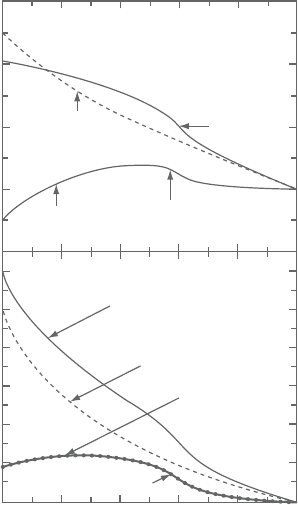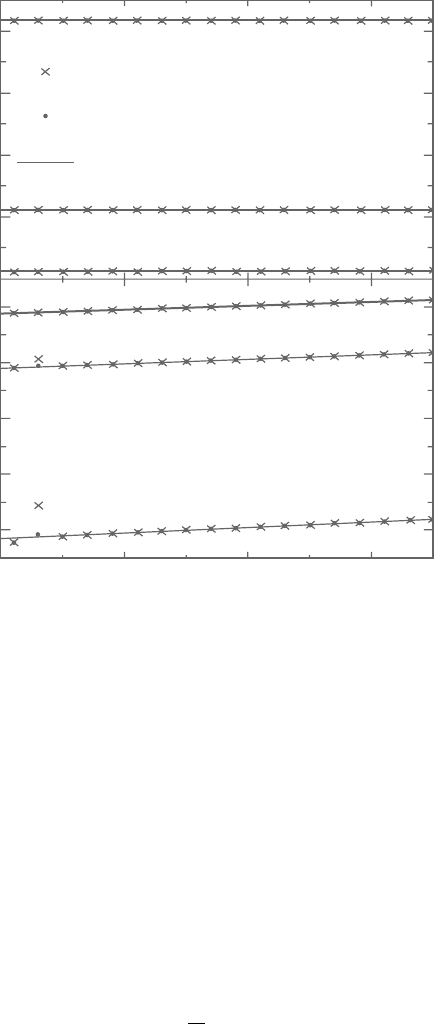Amano R.S., Sunden B. (Eds.) Computational Fluid Dynamics and Heat Transfer: Emerging Topics
Подождите немного. Документ загружается.


Sunden CH010.tex 10/9/2010 15: 22 Page 406
406 Computational Fluid Dynamics and Heat Transfer
By substituting equation (59) into equation (58), the following expression,
which is used to adjust the values of the nor malization constant of the smoothing
function, n
d
, yields:
n
d
=
1.0
/
F(s,h)dη
(60)
Equation (60) is essentially equivalent to the corrective interpolation for mulation
for a field quantity of zero-th order proposed by Liu et al. [15], which gives for the
1-D 3-spline quintic kernel, n
d
[39]
:
n
d
=
1
120
×
⎧
⎪
⎪
⎨
⎪
⎪
⎩
1.4632 1st closest particle to the boundary
1.0781 2nd closest particle to the boundary
1.0054 3rd closest particle to the boundary
1.0 other particles
(61)
The particle closest to the boundary gets the largest modification factor, 1.4632,
which implies that the “near-boundary deficiency” stays primarily with the closest
particle to the boundary.
10.4.4 Results
Figures 10.10 and 10.11 display the non-dimensional diffusive temperature and
heat flux distributions in thin films of different thicknesses yielding for Kn values
of 10 and 1.0, respectively. The overall agreement between the SPH and FDM
calculationsis excellentand moreaccuratepredictionscanbegiven by SPHforthe
heat conduction processes in solid films with smaller values of Kn.
The distributions for the total (summation of the ballistic and diffusive com-
ponents) temperature and heat flux were also calculated; the ballistic component
dominatesandduetoitsanalyticalformulationyieldsenhancedagreementbetween
the SPH and FDM results, as shown in Figure 10.12.
As seen from Figure 10.12, the calculated boundary temperature is not con-
stant, but increases as time advances. In Chen [31] this artificial temperature
jump is attributed to the inconsistency between the temperatures obtained in the
ballistic-diffusive calculation and the imposed boundary temperature. As men-
tioned previously, the imposed boundary temperature is the temperature of the
emitted phonon, not the equivalent equilibrium temperature at the boundary; how-
ever, the calculatedtemperature isthe temperatureof equilibrium phononsthat can
be understood as a measure of the local internal energy. The so-called equivalent
equilibrium concept can be visualized as the adiabatic thermalization equilibrium
state of the local phonons. In what concerns the SPH calculation, the temperature
ofthe particle closestto theboundarycannotbedetermineddirectlyfrom thespec-
ified temperature of the emitted phonons at the boundary, but depends on the SPH
smoothing interpolation. This fact explains why further treatment of the boundary

Sunden CH010.tex 10/9/2010 15: 22 Page 407
SPH – a versatile multiphysics modeling tool 407
Kn = 1.0
Lines : FDM
Symbols : SPH
t
* ⫽ 0.1
t
* ⫽ 0.01
t
* ⫽ 1.0
Non-dimensional position
Non-dimensional diffusive
temperature
Non-dimensional diffusive
heat flux
0.0
0.0
0.01
0.02
0.03
0.04
0.05
−0.02
−0.01
0.00
0.01
0.02
0.2 0.4 0.6 0.8 1.0
t
* ⫽ 0.1
t
* ⫽ 0.01
t
* ⫽ 1.0
Figure 10.10. Comparison between the SPH and the FD predictions for non-
dimensional diffusive temperature and heat flux with Kn=10.
Kn ⫽ 1.0
Lines : FDM
Symbols : SPH
t * ⫽ 0.1
t * ⫽ 0.1
t * ⫽ 0.1
t * ⫽ 0.1
t * ⫽ 10
t * ⫽ 10
Non-dimensional diffusive
temperature
Non-dimensional diffusive
heat flux
Non-dimensional position
0.0
0.00
0.05
0.15
0.25
−0.12
−0.09
−0.06
−0.03
−0.00
0.03
0.06
0.09
0.10
0.20
0.30
0.2 0.4 0.6 0.8 1.0
Figure 10.11. Comparison between the SPH and the FD predictions for non-
dimensional diffusive temperature and heat flux with Kn=1.0.

Sunden CH010.tex 10/9/2010 15: 22 Page 408
408 Computational Fluid Dynamics and Heat Transfer
Kn ⫽ 1.0
Lines : FDM
Symbols : SPH
t * ⫽ 1.0
t * ⫽ 1.0
t * ⫽ 1.0
Non-dimensional position
Non-dimensional temperature Non-dimensional heat flux
0.0
0.0
0.2
0.4
0.6
0.8
1.0
0.00
0.05
0.10
0.15
0.20
0.25
0.2 0.4 0.6 0.8 1.0
t * ⫽ 1.0
t * ⫽ 10
t * ⫽ 10
Figure 10.12. Comparison between the SPH and the FD predictions for non-
dimensional total temperature and heat flux with Kn=1.0.
is required. Figure 10.13 displays the contributions of the ballistic and diffusive
components to the total temperature (internal energy) and heat flux. The SPH cal-
culations reproduce the characteristics of the ballistic-diffusive heat conduction
reported in Chen [31].
Close observation of the calculation source data for all the 500 SPH particles
reveals an anomaly for the SPH heat flux result for the second particle away from
the boundary. The heat flux of this particle is inconsistent with the overall trend of
the heat flux profile and clearly deviates from the FDM predictions. This par ticle
was not shown in Figure 10.10 due to the limited amount of particles (only 50)
selected.The implementation of equation (61) can affect the symmetry of the SPH
formations, in particular that given by equation (55), which may explain the cause
forthisanomaly.Atestsimulationdemonstratesapossibleremedyforthisanomaly
is the use of a ad hoc operation: artificially increase the n
d
of the second par ticle
close to the boundary to 1.234 (mid value of the n
d
-s for the first and third particle
away from the boundary), which yields [39]
n
d
=
1
120
×
⎧
⎪
⎪
⎨
⎪
⎪
⎩
1.4632 1st closest particle to the boundary
1.234 2nd closest particle to the boundary
1.0054 3rd closest particle to the boundary
1.0 other particles
(62)

Sunden CH010.tex 10/9/2010 15: 22 Page 409
SPH – a versatile multiphysics modeling tool 409
Kn ⫽ 1.0, t ⫽ 1.0
Solid Lines : FDM
Symbols : SPH
0.0
0.0
Non-dimensional temperature
Non-dimensional position
Artificial wave front
Artificial wave front
Diffusive
component
Diffusive
component
Ballistic component
Ballistic
component
Total
Total
Non-dimensional heat flux
0.1
0.2
0.3
0.4
0.5
0.6
−0.1
0.0
0.1
0.2
0.3
0.2 0.4 0.6 0.8 1.0
Figure 10.13. Contribution of the ballistic and diffusive components to the non-
dimensional total temperature and heat flux.
Increasing the n
d
valueof the second closest particle to the boundary improves the
symmetry contributions amongthe particles in thevicinity of theboundary region,
in particular the symmetry between the first and second closest particles to the
boundary. By plotting all the SPH particles near the left boundary, Figure 10.14
clearly indicates the limitation of the treatment formulated by equation (61).
The use of equation (62) provides an effective ad hoc modification for the n
d
byeliminating the observed heat flux anomaly and it does not influence the overall
calculation accuracy.
10.5 Mesoscopic Pore-Scale SPH Model for Fluid Flow
in Porous Media
Manyindustrial applications involve flow inporousmedia, such as oilexploration,
groundwater purification from hazardous wastes, and packed bed chemical reac-
tors. One application area of particular interest is in liquid composite molding

Sunden CH010.tex 10/9/2010 15: 22 Page 410
410 Computational Fluid Dynamics and Heat Transfer
0.04
Kn = 10
SPH with boundary treatment
expressed by eqation (61)
SPH with boundary treatment
expressed by eqation (62)
FDM
t * = 1.0
t * = 0.1
t * = 0.1
t * = 1.0
t * = 0.01
t * = 0.01
0.03
0.02
0.01
0.00
0.000
−0.005
−0.010
−0.015
−0.020
0.000
Non-dimensional diffusive
heat flux
Non-dimensional diffusive
temperature
0.010 0.020
Non-dimensional position
0.030
Figure 10.14. Error resulting from the boundary treatment expressed by equa-
tion (61) and the ad hoc correction effect by using equation (62).
(LCM), a process being widely used to manufacture polymer composite compo-
nents in the civil, aerospace, automotive and defense industries [40]. Important
LCMtechnologiesare theresin transfermolding (RTM)and thestructuralreaction
injection molding (SRIM), and for both cases the understanding of the physics of
liquid flow in the porous preform is a requirement for the design of the mold and
the choice of the operation procedure, which are critical to the quality of the final
product. To this goal CFD numerical modeling can effectively reduce the experi-
mental parametric investigation effort needed for the optimization of the industrial
process.Therefore,it canplayanimportant rolein practice.CFD modelingof fluid
flow in porous media is in general conducted by using Darcy’s law [41, 42], which
is expressed in the following form:
v=−
K
µ
∇P (63)
Sunden CH010.tex 10/9/2010 15: 22 Page 411
SPH – a versatile multiphysics modeling tool 411
where, <v> and P are the volume averaged (superficial) velocity and the pressure
of the fluid (bold text denotes vector or tensor); K is the permeability tensor of the
porous medium; and µ is the dynamic viscosity of the fluid.
Darcy’s law is a macroscopic phenomenological model, which is largely based
on experimental observations. In this law, the complex interactions between fluid
and microscopic porous structures are all lumped in a macroscopic physical
quantity – the permeability tensor, K. As the permeability tensor is of paramount
importance to the fluid flow in porous media, numerous research efforts [42–45]
were devoted to establish theoretical relations between the permeability and other
characteristic material properties with the purpose of avoiding time-consuming
physical experiments.These theoreticalmodels are generally based on the analysis
of the microscopic porous structure of the medium and the subsequent extraction
of the desired macroscopic information. The complicated, diverse pore structures
in reality present a major challenge to pure (or semiempirical) theoretical models
because they are all constructed on the basis of artificially simple, regular pore
arrangements.
Obviously, the modeling of fluid flow in fibrous porous media directly from
the mesoscopic pore structure level provides refined fluid flow information and
it does not resort to Darcy’s law. Moreover, the simulated fluid field is amenable
to the determination of K as well. Over the last few decades, rapid advances in
computer capabilities andcomputational algorithms enabled thiskind of modeling
work. For example, the lattice-gas-automaton (LGA) or lattice Boltzmann method
(LBM) [46], based upon a micro- or mesoscopic model of kinetic formulations
or the Boltzmann equation, respectively, can bridge the gap between microscopic
structuresandmacroscopicphenomena.Thesemodelshavetheadvantageofallow-
ing parallelism in a straightforward manner for large-scale numerical calculations,
and they have the attractive feature of nonslip bounce-back solid boundar y treat-
ment for the simulation of fluid flow in porous media. The simulations based on
LGA [47, 48] and LBM [49–51] have demonstrated that Darcy’s law can be repro-
duced by these methods. The simulated porous media in the work by Koponen et
al. [49] describe three-dimensional (3-D) random fiber webs that closely resemble
fibrous sheetssuch as paper andnon-woven fabrics.The computed permeability of
these webs presents an exponential dependence on the porosity over a large range
of porosity and is in good agreement with experimental data [52, 53]. Spaid and
Phelan [51] investigated the resin injection process encountered in RTM. The cell
permeability obtained for transverse flow through regularly arranged porous tows
of circular or elliptical cross-section agrees well with the semi-analytical solution.
In contrast to LBM or LGA, SPH is a meshless particle-based method and offers
more freedomin dealingwith complicated geometries.Application of SPHto fluid
flow in porous media has the potential of providing a mesoscopic/microscopic
pore-scale insight into the relevant physics [54–57]. In the present work, SPH
is employed to construct a mesoscopic pore-scale model for fluid flow in porous
media,inparticular,forthetransversefluidflowinrandomlyalignedfibrousporous
media.

Sunden CH010.tex 10/9/2010 15: 22 Page 412
412 Computational Fluid Dynamics and Heat Transfer
10.5.1 Modeling strategy
SPH formulation and methodology
SPH formulation is directly based on the resolution of the macroscopic governing
equationsoffluidflow.DerivationoftheSPHformulationfromtraditionalEulerian-
based equations is routine, as described in Section 2; therefore, in this section is
only briefly surveyed.
InSPH,thecontinuousflowattimet isrepresentedbyacollectionofN particles
located at position r
n
(t) and moving with velocity v
n
(t), i=1,2,......,N. The
“smoothed” value of any field quantity q(r, t) at a space point r is a weighted sum
of all contributions from the neighboring particles
q(r,t)=
N
j=1
m
j
ρ(r
j
)
q(r
j
,t)w(|r −r
j
|,h) (64)
where,m
j
andρ(r
j
)denotethe massand densityof particle j, respectively.w(|r|,h)
is the weight or smoothing function with h being the smoothing length. In the
present SPH implementation, the high-order 3-splines quintic kernel [15] is used
andthesmoothinglengthh isequalto
√
2S,withS beingtheaverageseparation
oftheSPHparticles.IntheSPHformulationthegradientofq(r,t)isdeterminedas:
∇q(r,t)=
N
j=1
m
j
ρ
j
[q(r
j
,t) −q(r,t)]∇w( |r − r
j
|,h) (65)
Equation (65) is already symmetrized [24], and for the second order viscous
diffusive term, the SPH theory gives the following formulation [8, 24]:
1
ρ
∇·(µ∇q) =
j
m
j
ρ
n
ρ
j
(µ
n
+ µ
j
)q
nj
1
|r
nj
|
∂w
nj
∂r
n
(66)
where, q
nj
=q
n
−q
j
, r
nj
=r
n
−r
j
and w
nj
=w(|r
n
−r
j
|,h).
In terms ofequation (65), the “smoothed”version ofthe continuity equationis:
dρ
n
dt
=
j
m
j
v
nj
· r
nj
|r
nj
|
∂w
nj
∂r
n
(67)
The summationis overall neighboring particles j with exceptionof particle n itself
and v
nj
=v
n
−v
j
.
The transformation of the N–S equations into their SPH version is relatively
involved,becauseitrequiresthesymmetrizationofthepressureterms[24]tosatisfy
momentumconservation, and theadequate treatmentofthe viscousterms. InSPH,

Sunden CH010.tex 10/9/2010 15: 22 Page 413
SPH – a versatile multiphysics modeling tool 413
the symmetrization version of pressure gradient can be formulated as:
1
ρ
n
∇p
n
=
j
m
j
p
n
ρ
2
n
+
p
j
ρ
2
j
r
nj
|r
nj
|
∂w
nj
∂r
n
(68)
Fromequations(66)and(68),thestandardSPHformofN–Sequationisderived[8]
dv
n
dt
=−
j
m
j
p
n
ρ
2
n
+
p
j
ρ
2
j
r
nj
r
nj
∂w
nj
∂r
n
+
j
m
j
µ
n
+ µ
j
v
nj
ρ
n
ρ
j
1
|r
nj
|
∂w
nj
∂r
n
+F
B
(69)
where, F
B
denotes an external body force. In this work, the following SPH
expression for the momentum equations is used.
dv
n
dt
=−
j
m
j
p
n
ρ
2
n
+
p
j
ρ
2
j
+ RG
η
nj
r
nj
|r
nj
|
∂w
nj
∂r
n
(70)
+
j
m
j
(µ
n
+ µ
j
)v
nj
ρ
n
ρ
j
1
|r
nj
|
∂w
nj
∂r
n
+ F
B
+
f
Equation (70) was proposed by Jiang et al. (2007) and it differs from the standard
SPH N–S equation in what concerns two terms on the right-hand side of this equa-
tion, namely: (a) RG
η
nj
, an artificial pressure, which is used to restrain the tensile
instability [58]; (b)
f , an additional force, which is introduced with the purpose
of correctly mimicking the no-penetrating restraint prescribed by the solid pore
structure. The ter m RG
η
nj
is calculated as follows:
G
nj
=
w
nj
w(S,h)
(71)
R =
⎧
⎪
⎪
⎪
⎪
⎪
⎪
⎪
⎨
⎪
⎪
⎪
⎪
⎪
⎪
⎪
⎩
ϕ
1
|p
n
|
ρ
2
n
if p
n
< 0
ϕ
1
|p
j
|
ρ
2
j
if p
j
< 0
ϕ
2
|p
n
|
ρ
2
n
+
|p
j
|
ρ
2
j
if p
n
> 0 and p
j
> 0
(72)
The factors ϕ
1
and ϕ
2
are taken to be 0.2 and 0.05, respectively. The exponential
η is dependent on the smoothing kernel as η ≥w(0,h)/w(S,h); 3.0 is adopted
for η in this work. The repulsive force f (per unit mass) is initiated from a porous
material particle and is applied to the neighboring fluid particles within a distance

Sunden CH010.tex 10/9/2010 15: 22 Page 414
414 Computational Fluid Dynamics and Heat Transfer
less than a threshold value r
0
. In these conditions, for most of the fluid particles,
f =0. f isassumedto beof the12-6 Lennard–Jones pairpotential form, namely
f (r) = φF
B
r
0
r
12
−
r
0
r
6
r
r
(r < r
0
) (73)
Determination of the constants: φ and r
0
were discussed in detail in Jiang et al.
[55]; the values r
0
=0.6S and φ =15.0 were found to be suitable for the present
SPH implementation.
The quasi-compressible method, presented in Section 2 is used to comply with
the incompressibility condition for the fluid. The values of p
0
and c
s
are taken in
accordance with the following relation
c
2
s
=
γp
0
ρ
0
= max
0.01U
2
,0.01F
B
L,
0.01Uµ
ρ
0
L
(74)
where, U and L are the characteristic (or maximum) fluid velocity and the
characteristic length of the geometry, respectively.
Thepositions ofSPH particles aredetermineddirectlyfrom theflowfield using
dr
n
dt
= v
n
(75)
Adirect numericalintegrationalgorithmisused toperform theintegrationofequa-
tions (67), (70), and (75). The time step t is adaptive and determined by the CFL
condition [8]
t = min
⎛
⎜
⎝
0.125h
max
n
(∼100.0U,|v
n
|)
,0.25
+
,
,
-
h
dv
n
dt
,
0.25h
c
s,n
⎞
⎟
⎠
(76)
On the right-hand side of equation (76), the quantity ∼100.0U is introduced in
the denominator of the first constraint to restrict it to a small value so that the
calculation advances mostly in a fixed small time step. In this way the accuracy
of the integration procedure can be enhanced and the calculation stability is also
improved.
Mesoscopic pore structures
The porous matrix is established by randomly packing a certain number of fibers.
Only the transverse flow across the fibers is simulated in the present implemen-
tation. Typical 2-D porous microstructures are illustrated in Figure 10.15. The
cross-sectional shape of the fibers is either circular (Figure 10.15a) or square
(Figure 10.15b), and the fibers can be either overlapped with no precondition-
ing (Figures 10.15a and b) or be isolated from each other (Figure 10.15c). Each
porous system is formed by packing fibers of fixed cross-section (shape and area).

Sunden CH010.tex 10/9/2010 15: 22 Page 415
SPH – a versatile multiphysics modeling tool 415
(c)
(a) (b)
Figure 10.15. Typical 2-D porous microstructures formed by randomly packing a
number of fibers: (a) fibers are of circular cross-section with unlim-
itedoverlappingbetweenfibers; (b)fibersareofsquarecross-section
with unlimited overlapping between fibers; (c) fibers are of circular
cross-section and the fibers are isolated from each other.Void space
represents the fluid region.
Different porous systems have fibers of different cross-sectional shapes, different
cross-sectional areas or different relative arrangement conditions.
BoththeresinfluidandthefibersarerepresentedbySPHparticles.Thepositions
of the SPH particles used to represent the solid pore matrix are fixed throughout
the simulation. Thus, the porosity ε of a porous system is determined as:
ε = 1 −
number of fixed particles
total number of particles
(77)
Fixedporousmaterialparticlescontributetothedensityvariationsandexertviscous
forces upon the nearby fluid particles, while their densities are kept constant. The
no-penetrating restraint prescribed by solid pore structure is ensured by activating
a repulsive force, as expressed by equation (73), on a fluid particle once it is away
fromaporousmaterialparticlebyadistancelessthanr
0
.Withthisadditionalforce,
thefluidparticlesaredirectedtopassbytheporestructuresinphysicallyacceptable
paths [55].
Other relevant conditions
Thesimulateddomainisa2-Dsquareofdimensions10mm×10mmwithperiodic
boundary conditions appliedin boththe streamwiseand transverseflowdirections.
